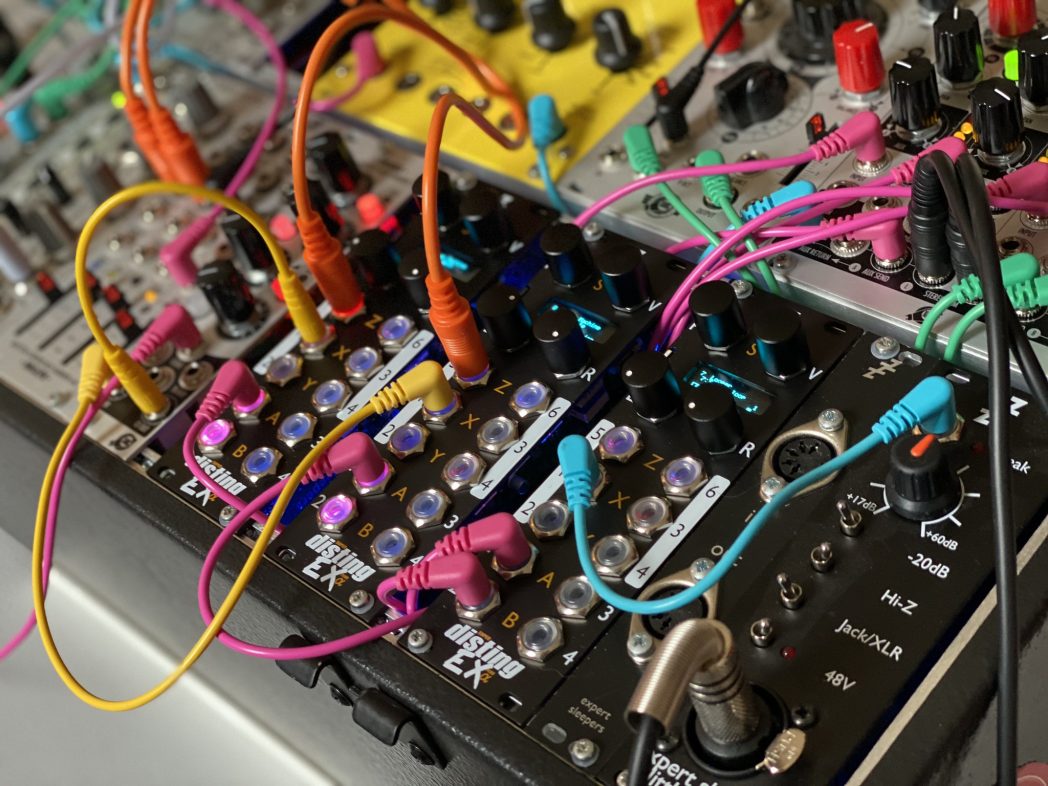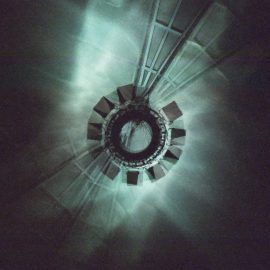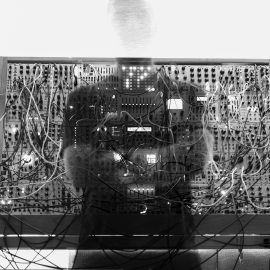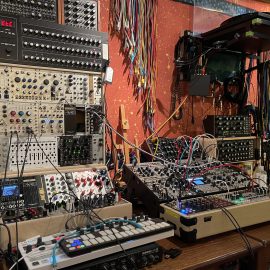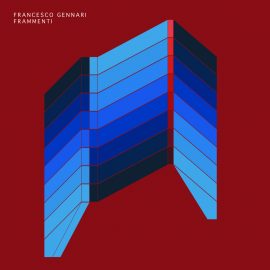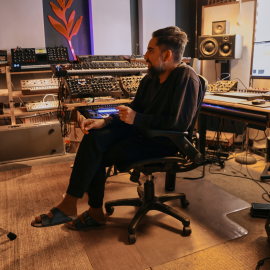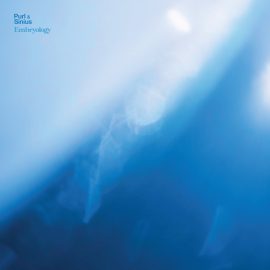There comes a moment in every musician’s life, when, beyond exploring their favourite instrument, they start to venture offroad in search of pleasures found beyond. I think that everyone I know has read about, watched a video, or touched a modular synth [if perhaps even in their dreams], then finally convinced themselves that, yeah, I think I need that module. There is a breaking point… and they break [I know I did], and finally dive deep into the world of modular. Soon after, the beast is hungry for more juice and multiplies into a monster. But somewhere around the count of three or four or half a dozen modules, the inevitable need for a “utility” becomes a must. Once you’ve connected all those toys, you want to interface with more – with MIDI, and of course, your DAW. You also need to “shift” and “slew” and “multiply” all of that voltage to be precise in your entire signal chain. You start to research, ask your friends, and then inevitably hear of Disting – the multifunction module, the “Swiss Army Knife”, the one to rule them all, the biggest bang for buck and space inside your Eurorack case. So what is this multi-algorithm unit, and why must every modular setup include at least one in their skiff?
The module that I’ll cover here today is called Disting EX, which is the latest incarnation of the ideas within the arsenal of modules by Expert Sleepers, a one-person company, run and operated by Andrew Ostler from Edinburgh, UK. The EX is the culmination of its predecessor, the Disting MK4, and in fact contains within it two (2) MK4s themselves, which operate in parallel or dual-mode, a bit “souped-up” (it runs at 96kHz instead of 75kHz), and, most importantly, features new and exciting algorithms (in its single-mode), which wouldn’t be possible even if you combined two MK4s yourself. In other words, I recommend you skip the MK4 and just grab the EX if you’re just starting out, and once you become comfortable and want to add more functions to your kit you buy a few more MK4s to make you happy. Inside, the unit comes with over a hundred unique algorithms, and Andrew keeps on adding even more! Each algorithm is a function that takes 3 inputs (X, Y, Z) and produces two outputs (A and B). If you’re familiar with functional programming, essentially it’s an abstraction over the many real-time processing functions with three parameters sent in and two return values out. At this point, the genius behind Andrew’s idea is to just write these algorithms (in software), which are then installed on the device (via firmware), and can now interface with everything inside your skiff.

Was that a bit confusing? OK, so let me break it down a bit some more. Let’s say you want to multiply two signals. We’ll take an audio signal, where amplitude (its volume) is expressed in voltage, and multiply it by a fluctuating number between 0 and 1, essentially controlling (modulating) its volume, the way an amplifier would. To do that, you select the “Four Quadrant Multiplier” algorithm on the Disting, insert your signals into the defined inputs respectively (X and Y) and use the output (A) for your return value. This very basic formula is X * Y = A. With this very basic function, you can feed in an envelope to apply to your original audio signal, and use the Disting as a VCA. If you feed in another audio signal as your input to multiply the two, you effectively get a “ring modulator“.
Unfortunately, because the Disting is packed with so many algorithms, all packaged to reuse the minimal interface, you won’t remember all the “formulas” and their defaults – and reading all this “documented code” is more than necessary for the operation. I often have to keep the latest manual up on my iPad, and if I don’t use Disting for a week or so, I have to go through a refresher on the knobs. The good news is that the manual is very detailed and comes with links to YouTube videos for demos of every listed algorithm. Since menu-diving here is more than optional, there’s even an iOS app called Synth Modes (developed by a third party) that acts as a “cheat sheet” to the many covered functions. Once you get the hang of it, however, the operation is straightforward, and you’ll be jumping from one algorithm to another in no time. Besides the multitude of “utilitarian” algorithms, Disting comes with its own unique oscillators, modulation generators, audio recording and sample playback capabilities (there is a MicroSD slot), and numerous effects. Let’s dig into a few of my personal favourites!
“Audio Playback” is perhaps the easiest function to understand (besides addition and multiplication). This algorithm does exactly what it says – it continuously plays stereo audio files, looping them forever, with a few extra inputs for some voltage control. Grab the MicroSD card, dump a folder of textures, vocals, or drum loops, load up the algorithm, and you’ve got yourself a playback device. I’ve used it to drop-in looping techno beats, which I have further processed with the modular, applying the envelope follower to the transients and generate more pulses with the rhythm (I use Xaoc‘ Sewastopol II). In this algorithm, the X input takes in CV for a retrigger, while the Y input specifies the initial playback position of the sample. Connect these to some semi-random signal generator (like Marbles!) and you can instantly create some glitching, stuttering, and jittering beats. Or use it to playback a long evolving sample (I have one with a man’s voice counting numbers to 20) and feed the output through various modular toys (like Beads!) to warp, delay, and filter to your liking. Additional algorithms include even more controlled audio playback, where the speed of the sample is set by the incoming clock, or the pitch of the sample is set by v/Oct input (so load in a minor chord sample, and use your sequencer to play), or you can “scrub” the sample against a virtual “tape head” using the CV for the position (sounds like a DJ scratching a CD).
We’ve covered some basic sample playback, but what about a drum machine function? In its “single-mode”, the EX offers an algorithm just for that, offering 6 separate voices with independent triggers. So, go ahead, load up a kick drum sample, snare, hi-hat, cymbal crash, and more! Now hook up a sequencer or a controller with separate gates for each voice (like the Arturia‘s Beatstep Pro), and now you have yourself a sample-based drum machine! And yes, the gate inputs are all velocity-sensitive! If you don’t have a controller with dedicated triggers, then don’t worry – the Disting is fully compatible with MIDI, which you can expand with a simple and cheap MIDI Breakout module. Now you can also trigger the samples with MIDI notes, directly from your keyboard. MIDI is further incorporated into other various algorithms, including the ones that can convert MIDI to CV and back! So now you can finally connect that crazy random LFO module you love and drive a cut-off frequency on a filter of your favourite non-modular synth! I’ve used it to create complex curves with Mutable Instruments Stages, convert these voltage values to a MIDI CC, and drive the filter envelopes on my Medusa, Access Virus C and Clavia Nord Lead. Amazing!
Another indispensable utility function in any modular setup is quantization. With the infinite possibilities of the voltage sweeps, the pitch of your oscillator can quickly get away from you and stop being ‘musical’. This is especially prevalent with the usage of random voltage generators (my favourite is Make Noise Wogglebug). By quantizing the voltage you’re forcing the pitch to fall in step within musical scales, essentially making your uncontrolled chaos ‘pretty’ again. Not only will the Disting quantize and transpose your signal to 15 possible scales, but it will also output a resulting MIDI note (on that breakout module I mentioned) to your other machines. If the 15 available scales are not enough, you can program your own detailed tunings (including microtonal scales) using Disting’s support for Scala. A quantizer was one of the most essential utilities in my beginner’s arsenal when I first attempted to subdue the beast. There are a lot of modules out there specializing in quantization alone, and with the Disting, you’ve got the basics covered! Speaking of randomness – yes, Disting comes with its own “Sample and Hold” algorithm, which could source the signal from its own internal noise generator of three different colours. And if you love randomness, then wait till you discover the “Shift Register Random Quantized CVs” algorithm!
First of all, if you’ve read this far already, you deserve a special prize from me. And that prize is, well, this rotating shift register circuit emulation, which, in some modular circles is sometimes referred to as the Turing Machine (see this Music Thing Modular unit). Without going into the details on how it works, what you essentially get is an output of randomly changing control voltages which you can also “lock” to repeat as loops for generative sequences. In the case of Disting’s algorithm, these voltages can be also quantized to a scale discussed in a paragraph above. All you need to do is give it a clock, and it will produce a set of quantized CVs along with a trigger. Feed this into your favourite oscillator, and a gate of an envelope, and you have a forever looping random sequence, which you can nudge every so often with another input or the probability of randomness setting. Besides the random ‘notes’, there is a separate algorithm for just triggers, which you can use on all your drums. You can change the length of the sequence (up to 32 values) as well as a slew rate (a setting of ‘1’ will give the very quick ‘glide’). This is a super quick, fun, and rewarding way to get at those sequences that you didn’t need to program yourself. I happen to find one I’m in love with every time!
If bit shifting is not enough to produce new and unique patterns, you may want to check out the Euclidean rhythms, which are also available on the Disting! Again, I won’t go into the theoretical background of generative music using the Euclidean algorithm (read the complete details in this Godfried Toussaint’s paper), but if you like some syncopated beats, this polyrhythm generator is for you! The Disting H5 “Dual Euclidean Patterns” will produce two separate pulses, which you can hook up respectively to gates on an envelope generator or triggers on your drum machine. You can specify the number of “pulses” used within the defined range of steps, and the algorithm will distribute them according to the formula: so 4 pulses in a 16-step beat will sound like a ‘regular’ techno kick pattern, but things get a lot more interesting with 5 pulses, 6, or 7, etc. Overlay a second pattern with a snare, and you’ve got an interesting beat. With the EX, go ahead and use the algorithm twice for four separate rhythms, or combine it with the quantized output of the Turing Machine described above, for even more generative fun!
A quick note on the numerous audio effects that are available with the module. You’ve got your set of basic tape delays, stereo ping-pongs and echos which you can sync up to the clock or control with a CV. You’ve got a few reverbs with some impressively large room sizes and even a freeze capability for that never-ending tail. There’s also a chorus, a granular pitch shifter, a rotary speaker effect, a “DJ Filter”, and even a vocoder. You have to read the full list to believe it. And although some of these are not as advanced and flexible as dedicated modules, you know that a bit of reverb and delay on all your dry signal can go a long way in making even a few bleeps and bloops stand out. A very simple setup can include algorithm C3, “Clockable Ping Pong Delay” for your mono audio input on one half of the Disting, feeding the stereo output of that into the algorithm L1, “Stereo Reverb” in the other half of Disting. Set these to just a tad of feedback and wet/dry mix near the end of your audio chain and I guarantee that you will feed most, if not all, of your audio signal through it.
I was going to close this brief overview (trust me, it is brief, I barely covered 10% of all of the functions) with a description of another algorithm, like the “Augustus Loop”, or the “WAV Recorder” with a built-in auto-sampler, or the stomp-box “Looper” implementation, or the amazing “Dream Machine” inspired by La Monte Young theories, or the incredible “Granulator” which is a full-blown granular synthesis engine, most likely requiring its own independent write-up (watch this entire YouTube playlist)… but as I was feverishly typing these 2,000+ words out (over a course of a week, mind you), Andrew released yet another (!!!) new version for the EX, adding two new algorithms: the “Multi FX” monster with chained EQ, Delay, Reverb and Pitch, and an “Oscilloscope”! As some of these become even more complex, there is a lot more menu diving through the available parameters (the “Granulator” has 62 and the “Multi FX” has 63 various settings), but I honestly can’t complain about this. I’ve purchased Disting once, and now, with a simple firmware update, I get to play with all new algorithms, essentially for free! Anyway, if you’ve read through all these words, and are even a little fascinated by the multitude of functions in a single box, I wouldn’t blink, and grab the Disting EX (or two!) for your expanding modular collection! It’s pretty much a must!
